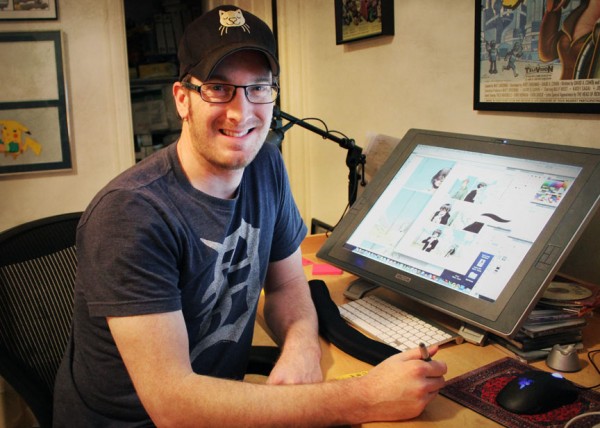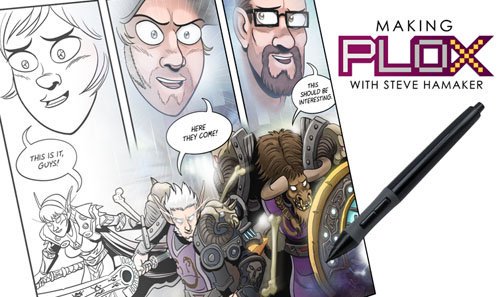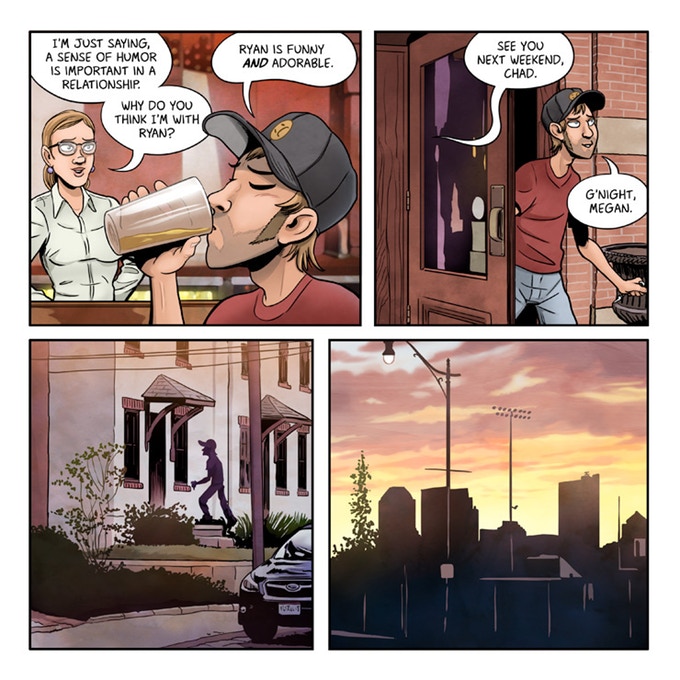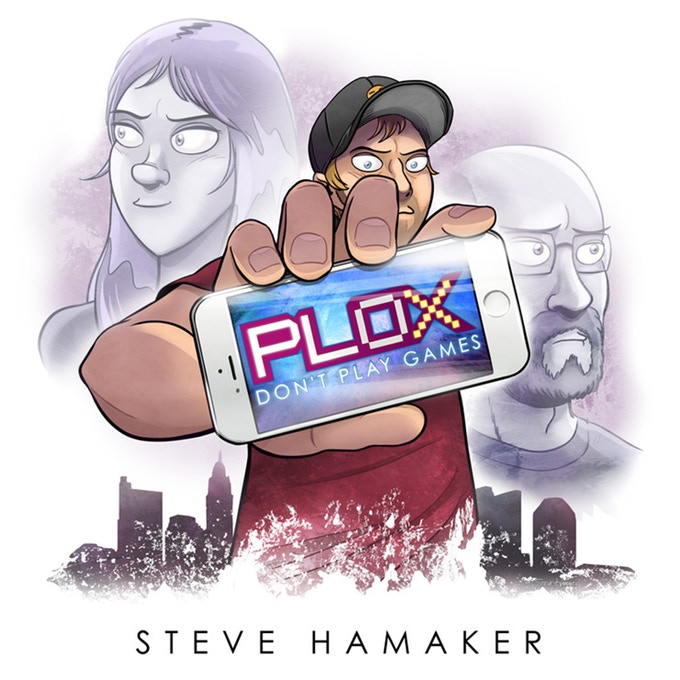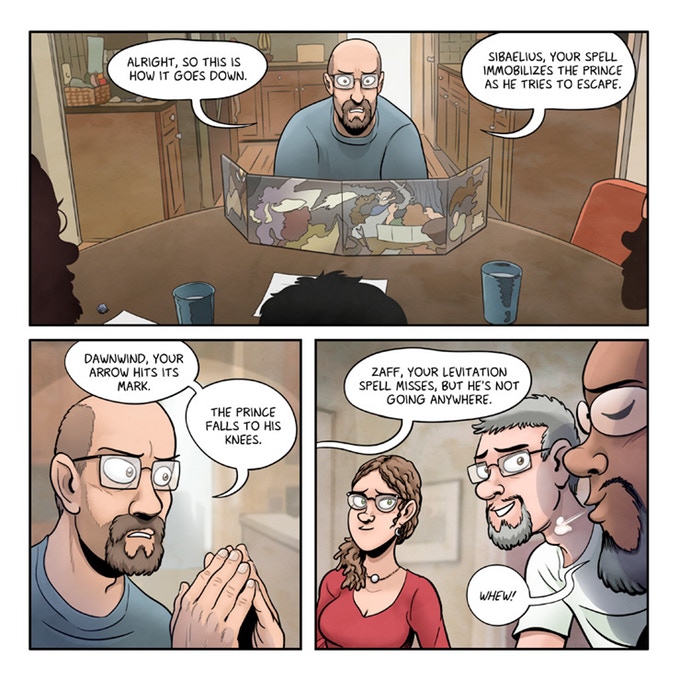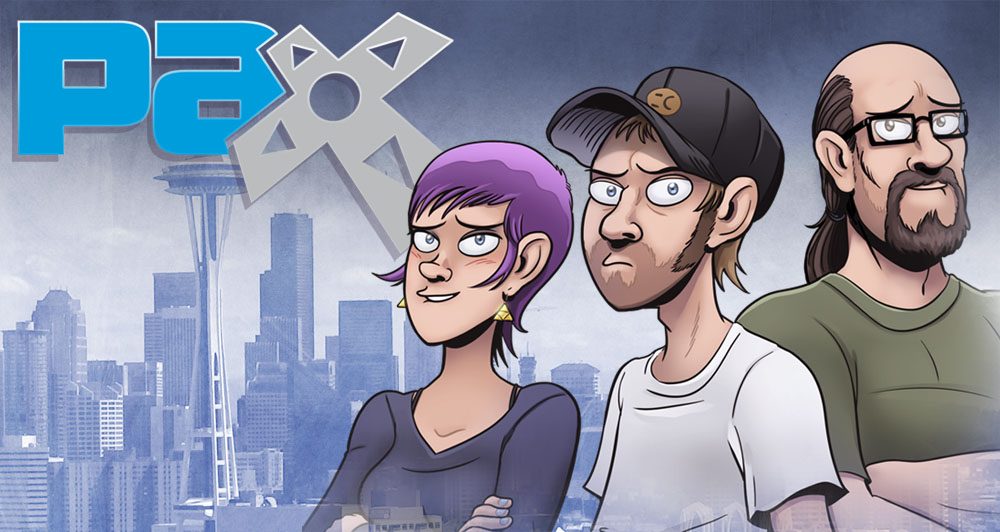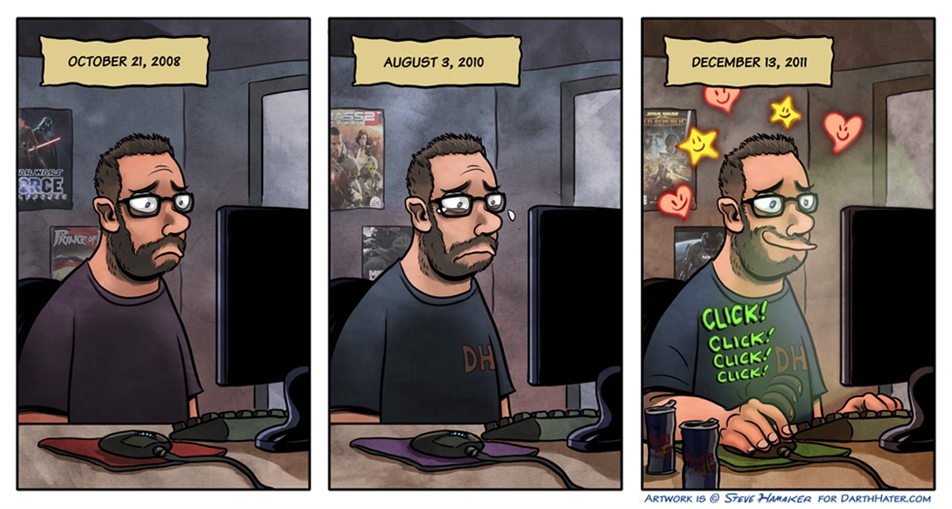Steve Hamaker ranks tragically high in the ratio of most read to least recognizable cartoonists. Jeff Smith BONE was a giant indie success as a black-and-white comic book series, but it hit the mainstream when it was released as a series of graphic novels by Scholastic with vibrant colors from Hamaker. Hamaker went on to color comics from luminaries like Scott Kurtz, Terry Moore, Judd Winick, among others. For the past several years Steve has been making the webcomic PLOX as the writer, artist, and colorist, demonstrating how much he’s learned from his collaborators in a series with effective storytelling and wonderful cartooning. Following up on our previous interview, I talked to him again about the webcomic and the current Kickstarter to print the second volume.
More readers need to learn about you as a cartoonist, but I have a couple questions about your coloring work. Firstly, who are some of your biggest influences as a colorist?
I became a colorist by accident, so I didn’t really have many specific influences growing up. I was working for Jeff Smith as a product designer back in 2000 and I was literally playing around in Photoshop with a few BONE pages. He saw what I was doing and obviously approved, so from that point on I switched gears to become his colorist for the next 12 years. I was later influenced by the people I met along the way. Around 2004, I became friends with Kazu Kibuishi along with his artist pals that all contributed to the Flight anthologies. He invited me to create a few stories for those books and that taught me so much about comics and color.
Dave Stewart was also a big influence. I always loved how simple his coloring was. He proved that you didn’t have to over render each panel or page. He used color to complete what Mike Mignola had designed in black & white. Jeff and I definitely adopted that philosophy for BONE.
You color the work of some of the very best creators in comics. How do you choose artists to work with?
I mostly color for people that are friends of Jeff Smith [Laughs]. I was always tagging along at the comic cons, dinners, parties, and I was able to meet people like Terry Moore, Judd Winick, and Mark Osborne. They each appreciated my color work, but they also just became my friends. I have been very lucky, but I also push myself to create the best work possible. All of the artists that I’ve colored for are like me, we hold ourselves to an impossibly high standard, so we get along.

How much attention do you pay to other comics colorists? Do you actively study output from current big names like Jordie Bellaire and Matt Wilson?
I don’t pay much attention because I’m usually too busy to read comics [Laughs]. I love Jordie and Matt’s work, and I try to keep my eye on things going on in comics overall, but I’m pretty out of touch with the trending artists.
I like to encourage young colorists and cartoonists more than anything. It’s very satisfying to share what I know and help younger artists find their way.
How much has your art style been influenced by working with artists like Jeff Smith and Scott Kurtz, both of whom have line work with similar sensibilities?
I have been completely influenced by Jeff and Scott! Working for Jeff for over a decade taught me everything about cartooning, publishing, self-promotion, you name it! Scott and I are close friends now but his style was a big influence ever since I fell in love with his comic PVP.
Jeff Smith and Terry Moore were such massive examples of how to correctly draw comics, and they do things very differently from each other. Jeff has a very cinematic eye when it comes to panel and page composition, and Terry’s approach feels more like episodic television. Terry’s comics are maybe less dramatic visually, but he uses a specific ‘camera’ position to show intimacy and emotional moments with attention to his characters’ facial reactions and dialogue.
We talked about the square format used in pages of PLOX in our previous interview, but I have a new question. How does it compare to a more traditional strip format, like what Scott Kurtz uses in PVP?
Scott was trying to use the same format as any strip cartoonist, Charles Schulz, Bill Watterson, etc. I always loved both formats for telling stories, the regular 6” x 10” comic page and the 3 or 4-panel strip layout. The square format just clicked for how I was writing scenes for PLOX. It’s hard to describe why it worked, but I tried drawing PLOX in a regular comic format and I couldn’t write it the way I wanted. The square pages also fit better on a computer screen, so you don’t have to scroll to read each page. I liked that part too.
Was there any hesitation to draw a book taking place in a similar setting as Table Titans?
At first, PLOX was going to be a lot like Table Titans, the characters in and out of the video game. I quickly realized that it was the wrong direction for my characters. I had to establish Chad’s in-game persona, but I dropped the idea of having scenes inside the World of Warcraft with each of the characters’ avatars. The story is about the people, not the game.
How directly do you tackle touchy subjects like GamerGate in PLOX?
I don’t like to get too preachy or anything, but I do feel a responsibility to show my characters overcoming obstacles in their lives in a genuine way. If it happens to be a big social issue, that’s more accidental than anything.
It sounds cheesy, but I let my characters tell me how they are going to handle their problems. In the second book, there is a male character that acts sexually inappropriate towards Kim, but I wanted to let her handle it in her own way. She’s strong and self-confident, so she doesn’t have to run home in anger or fear. Chad’s reaction was also important. He knows that Kim doesn’t need a knight in shining armor, but he still wants to stand up for her honor. The way he does that is very specific to his personality, and I hope it feels natural.
Given the infinite scope of the internet, marketing a webcomic can be even harder than promoting something coming to comic shops. How are you bringing attention to PLOX?
It’s very difficult! I use social media to get the word out the most. Twitter and Facebook are the main places that the readers can engage with me and PLOX. Outside of having a $10,000 marketing budget, it really takes a long time to establish an audience. I feel like I still have a long way to go.
From there, how do you convert readers into Patrons or backers on Kickstarter?
I think the regular readers understand my overall publishing plans. I just try to communicate as much as possible to make sure they know what I have coming. The Patreon supporters are a major core audience for PLOX with ongoing support. I try to provide them with rewards and sneak-previews as much as possible. I don’t really try to convert the readers, but I like giving them opportunities to support the making of the story if they choose.
Have you found funding the second volume of a series easier or more difficult than your first Kickstarter?
It’s a little harder this time, but I am confident that we will get there. I think that it’s an awkward time of the year, but we seem to be heading steadily toward the goal.
As I’m sure you know, crowdfunding is only the beginning of selling your work. How do you help to sell both volumes of PLOX after the Kickstarter concludes?
I have a Big Cartel store linked on the main PLOX site and I sell books at a few conventions throughout the year.
This year I will be exhibiting at a great new gaming show here in Columbus called GDEX. That should be fun since it’s a different audience than a regular comic con.
What’s your ultimate goal as a cartoonist? Do you want to build an empire like Scott Kurtz, sell millions of books like Jeff Smith, or is your goal less about the results and more about how you get there?
I am definitely interested in becoming a bigger success as a colorist and cartoonist, but the journey is important. Each project I work on takes me to the next project and so on. If I stopped making comics today I would be totally satisfied with my career, so everything ahead of me is icing on the cake!
You can follow Steve Hamaker on Twitter @SteveHamaker. His Kickstarter campaign has about a day left and is only a little short of reaching its goal so if you like what you’ve read please go contribute if you can.
MATT CHATS is an interview series conducted between Matt O’Keefe and a creator and/or player in the comic book industry, diving deep into industry, process, and creative topics. Find its author on Twitter and Tumblr. Email him with questions, comments, complaints or whatever else is on your mind at [email protected].


